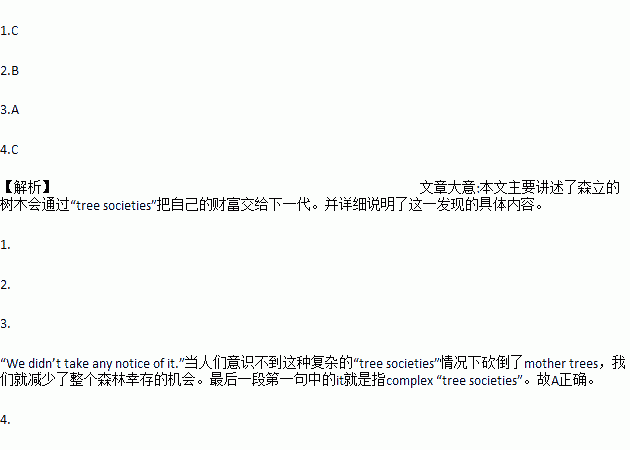题目内容
Would it surprise you to learn that, like animals, trees communicate with each other and pass on their wealth to the next generation?
UBC Professor Simard explains how trees are much more complex than most of us ever imagined. Although Charles Darwin thought that trees are competing for survival of the fittest, Simard shows just how wrong he was. In fact, the opposite is true: trees survive through their cooperation and support, passing around necessary nutrition “depending on who needs it”.
Nitrogen (氮) and carbon are shared through miles of underground fungi (真菌) networks, making sure that all trees in the forest ecological system give and receive just the right amount to keep them all healthy. This hidden system works in a very similar way to the networks of neurons (神经元) in our brains, and when one tree is destroyed, it affects all. Simard talks about “mother trees”, usually the largest and oldest plants on which all other trees depend. She explains how dying trees pass on the wealth to the next generation, transporting important minerals to young trees so they may continue to grow. When humans cut down “mother trees” with no awareness of these highly complex “tree societies” or the networks on which they feed, we are reducing the chances of survival for the entire forest “We didn’t take any notice of it.” Simard says sadly. “Dying trees move nutrition into the young trees before dying, but we never give them chance.” If we could put across the message to the forestry industry, we could make a huge difference towards our environmental protection efforts for the future.
1.The underlined sentence “the opposite is true” in Paragraph 2 probably means that trees ________.
A. compete for survival B. protect their own wealth
C. depend on each other D. provide support for dying trees
2.“Mother trees” are extremely important because they ________.
A. look the largest in size in the forest
B. pass on nutrition to young trees
C. seem more likely to be cut down by humans
D. know more about the complex “tree societies”
3.The underlined word “it” in the last paragraph refers to ________.
A. how “tree societies” work B. how trees grow old
C. how forestry industry develops D. how young trees survive
4.What would be the best title for the passage?
A. Old Trees Communicate Like Humans
B. Young Trees are In Need Of Protection
C. Trees Are More Awesome Thart You Think
D. Trees Contribute To Our Society

